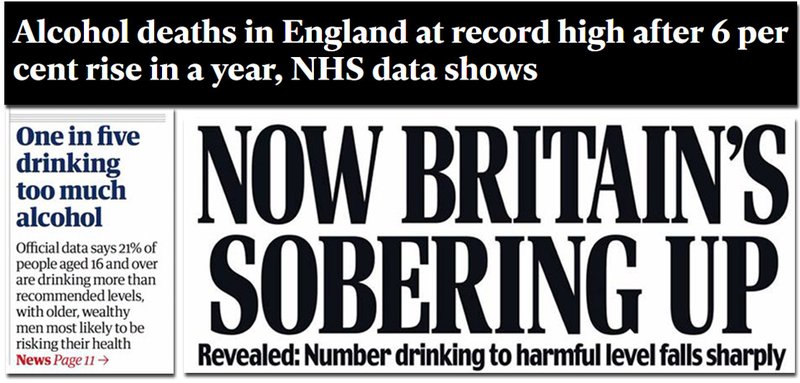The above headlines might seem to contradict one another. The Daily Mail
says that Britain is sobering up, while the Guardian
claims that a significant number drink too much, and the Independent
announces alcohol-related deaths are at a record high. So who’s right?
In fact, they all are. They are all reporting different parts of a new report published by NHS Digital. This underlines the importance of taking a broad view of health statistics, and not concentrating on a single figure which, in isolation, won’t tell the whole story. NHS Digital have only published a summary report so we’re not able to dig into the data in full.
In summary, the NHS’s data shows that, year-on-year, in England the percentage of adults reporting that they usually drink more than the recommended 14 units of alcohol per week has been falling. The English do seem to be drinking less, but many still exceed those guidelines, especially older, more affluent people.
The raw number of hospital admissions and deaths where the primary cause is directly attributable to alcohol is rising, but this doesn’t tell the whole story—because the total number of hospital admissions and deaths has also been rising in recent years. As a proportion of all hospital admissions, the percentage primarily linked to alcohol has actually remained pretty much the same over the last ten years. The same is true in terms of the number of alcohol-specific deaths per 100,000 people.
The number of adults drinking more than the recommended amount is down
21% of adults aged 16+ in England usually drank more than the recommended 14 units of alcohol a week in 2017. This level has been falling since at least 2012 (as far back as we can see data for).
28% of men are drinking over 14 units a week, compared to 34% in 2011. 14% of women are doing the same, compared to 18% in 2011.
This data is based on the Health Survey for England, in which 8,000 adults and 2,000 children are interviewed.
The findings are also consistent with those of a separate survey by the Office for National Statistics (ONS), which found that that 57% of over 16s drank weekly in Britain in 2017, having fallen from 64% in 2007.
Such surveys are a generally reliable way of sourcing information, and can be especially useful for making comparisons over time. However, it may be the case that both sources are somewhat underestimating how many people are consuming more than 14 units a week, because they rely on people accurately reporting how much they drink.
The ONS says that “Social surveys consistently produce estimates of alcohol consumption that are lower than the levels indicated by alcohol sales data. This is likely to be because people either consciously or unconsciously underestimate their alcohol consumption."
Older, wealthier people tend to drink more
Alcohol consumption tends to increase in older age groups (up to the age of 65), according to the NHS survey. Among both men and women in England, 55-64 year olds were the most likely to usually drink over 14 units a week. 36% of men aged 55-64 say they do this, as do 20% of women in that age group.
The likelihood of drinking over 14 units also increases in households with higher incomes. Among the 20% of households with the highest incomes, 35% of men and 19% of women usually drink 14 units or more a week, compared to 20% of men and 12% of women in the lowest 20%.
This finding is again broadly consistent with separate ONS data, which finds that the chance of an individual having drunk alcohol in the last week goes up as their income increases.
“In 2017/18 there were 338 thousand estimated admissions (in England) where the main reason for admission to hospital was attributable to alcohol”, NHS Digital reports.
It adds: “This is similar to 2016/17 and 15% higher than 2007/08.” However, the number of overall hospital admissions has also been going up over time, and there has actually been little change in what percentage of all admissions are primarily linked to alcohol. It was 2.1% in 2017/18, down slightly from 2.3% in 2007/08.
The range of conditions that can be linked to alcohol is quite large. Of the 338,000 alcohol-related admissions in 2017/18, the most common reason for admission was cancer, followed by unintentional injuries (each was the cause of just under a quarter of alcohol-related admissions). The next-most common diagnosis was mental and behavioural disorders.
61% of the patients were male and 69% were aged over 45.
There were 1.2 million hospital admissions where either the primary or secondary reason for admission was linked to alcohol. That accounted for 7.2% of all hospital admissions, and 52% of these admissions were for cardiovascular disease.
We can’t fairly assess how this has changed over time, because NHS Digital notes that “changes over a longer time period will partly reflect improvements in recording of secondary diagnoses”.
Alcohol-specific deaths
The number of alcohol-specific deaths has been rising over time, but it’s important to remember that so has the overall number of deaths in the population.
In England in 2017, there were 5,843 deaths that were a direct result of alcohol misuse (in 80% of cases this was alcoholic liver disease). This doesn’t include deaths that might be partially-attributable to alcohol—such as certain cancers.
The number of alcohol-specific deaths per 100,000 people has remained broadly stable since 2007—at around 15 per 100,000 males, and 7 per 100,000 females.
